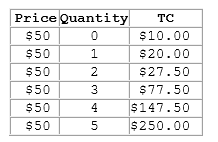According to the table shown, the firm's marginal costs:
This table shows the total costs for various levels of output for a firm operating in a perfectly competitive market.

A. are constant.
B. increase as output increases.
C. decrease until the 2nd unit, then increase.
D. increase until the 4th unit, then decrease.
C. decrease until the 2nd unit, then increase.
You might also like to view...
A shift in the consumption function:
a. is based on the marginal propensity to consume. b. can be caused by a change in the price level. c. can be caused by a change in GDP. d. None of these.
Assume that the government increases spending and finances the expenditures by borrowing in the domestic capital markets. If the nation has low mobility international capital markets and a flexible exchange rate system, what happens to the GDP Price Index and reserve-related (central bank) transactions in the context of the Three-Sector-Model?
a. The GDP Price Index falls, and reserve-related (central bank) transactions become more negative (or less positive). b. The GDP Price Index falls, and reserve-related (central bank) transactions remain the same. c. The GDP Price Index and reserve-related (central bank) transactions remain the same. d. The GDP Price Index rises, and reserve-related (central bank) transactions remains the same. e. There is not enough information to determine what happens to these two macroeconomic variables.
Real GDP is the yearly production of final goods and services valued at
a. current prices. b. constant prices. c. expected future prices. d. the ratio of current prices to constant prices.
In which of the following decades did the American government take a more "hands off" or "let it alone" approach in its role in the economy?
A. 1970s B. 1940s C. 1930s D. 1920s